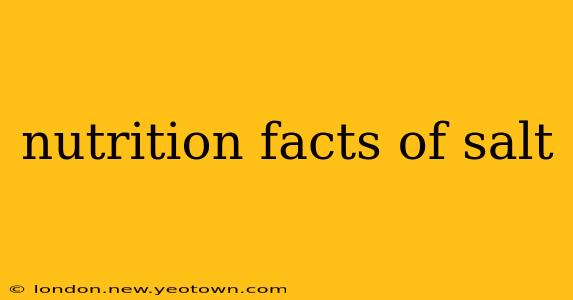Salt, that ubiquitous kitchen staple, is far more complex than its simple appearance suggests. While we all know it adds flavor to our food, understanding its nutritional profile—or lack thereof—is crucial for maintaining a healthy diet. This isn't about demonizing salt, but rather about demystifying its nutritional facts and understanding its role in our overall well-being.
Let's start with the basics: the primary component of table salt (sodium chloride) is sodium (Na) and chloride (Cl). Nutritionally speaking, salt itself provides negligible amounts of vitamins, minerals, or other essential nutrients. Its nutritional value lies primarily, and somewhat controversially, in its sodium content.
What are the main components of salt?
Salt's core components are sodium and chloride, both essential electrolytes. Sodium plays a vital role in maintaining fluid balance, nerve transmission, and muscle contractions. Chloride helps maintain proper fluid balance and is a component of stomach acid, crucial for digestion. However, it's crucial to remember that these elements are readily available from a variety of foods, making excessive salt consumption unnecessary and potentially harmful. Many processed foods already contain significant amounts of sodium.
Is salt a source of any vitamins or minerals?
No, salt itself is not a significant source of vitamins or minerals. While some fortified salts might contain added iodine (essential for thyroid health), the amount is generally small and not sufficient to meet daily needs. The nutritional benefits we associate with salt are actually the benefits of its component elements—sodium and chloride—which are already present in various foods in our diet. Relying on salt as a source of these electrolytes would lead to an unhealthy excess of sodium.
How much sodium is in a teaspoon of salt?
A teaspoon of table salt contains approximately 2,300 milligrams (mg) of sodium. This is roughly equivalent to about one gram of sodium, and it's a substantial amount considering the recommended daily intake. The recommended daily sodium intake for most adults is typically around 2,300 mg (or less), so just one teaspoon of salt already accounts for the entire recommended daily allowance.
What are the health risks associated with too much salt?
Excessive salt consumption is strongly linked to several health problems, including:
- High Blood Pressure (Hypertension): High sodium intake causes the body to retain water, increasing blood volume and thus blood pressure. This is a major risk factor for heart disease, stroke, and kidney disease.
- Heart Disease: High blood pressure damages blood vessels over time, leading to a higher risk of heart attacks and strokes.
- Stroke: High blood pressure increases the risk of blood clots, which can lead to strokes.
- Kidney Disease: The kidneys work harder to filter excess sodium from the blood, potentially leading to damage over time.
How can I reduce my salt intake?
Reducing salt intake is achievable with a few simple changes:
- Cook more meals at home: You have better control over the ingredients and salt levels.
- Read food labels carefully: Be mindful of the sodium content in processed foods, which often contain high amounts.
- Use herbs and spices: Enhance the flavor of your dishes with herbs, spices, lemon juice, or other natural flavorings instead of relying heavily on salt.
- Gradually reduce your salt intake: Your taste buds will adjust over time, allowing you to appreciate the flavors of food without excessive salt.
In conclusion, while salt plays an important role in flavor and some essential bodily functions through its sodium and chloride content, it's crucial to consume it in moderation. Understanding the nutritional facts of salt means recognizing its limited nutritional value and focusing on a balanced diet rich in nutrient-dense foods to meet your daily needs. Your health will thank you for it.

